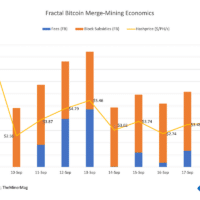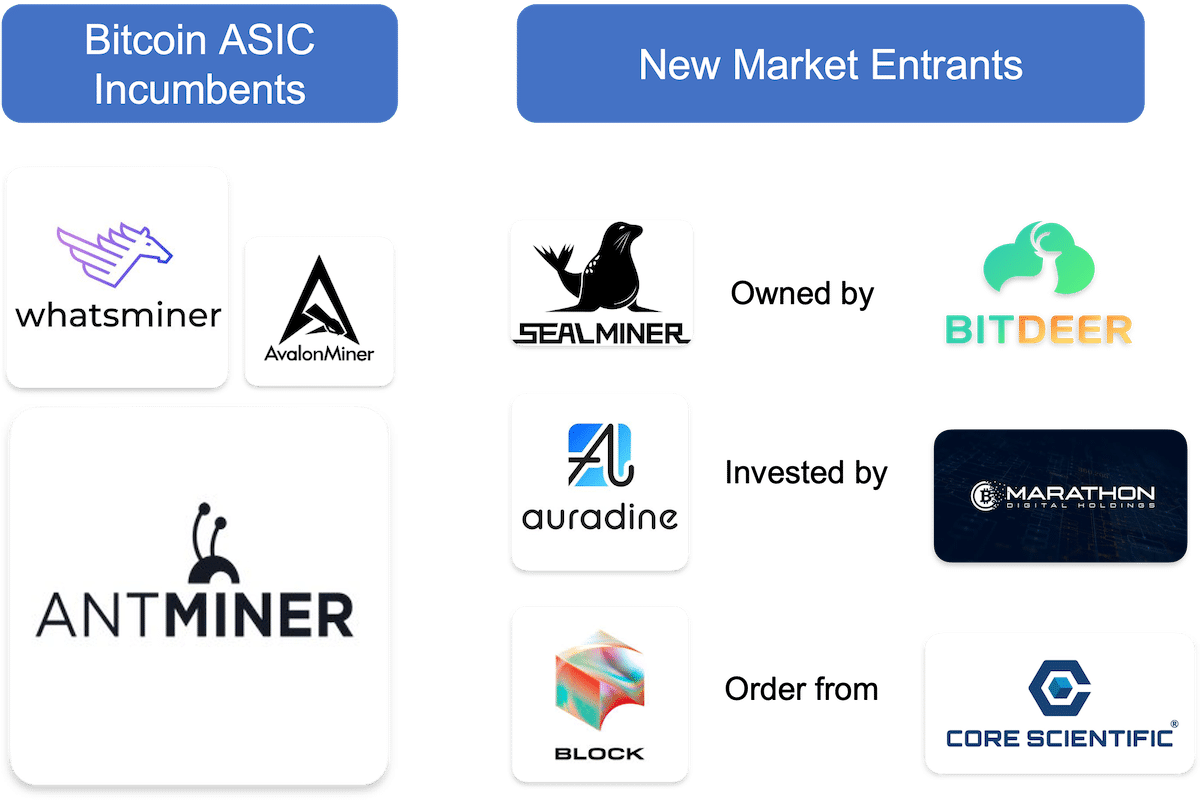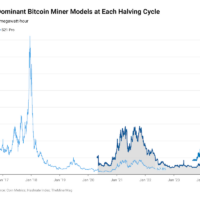Bitcoin mining can be a daunting subject for anyone new to it. Not only does the industry have various complex network metrics, but it is also deeply connected with the semiconductor, logistics, supply chain, construction, and energy businesses.
In this explainer, we zoom out and review the most important components of bitcoin mining with two questions in mind: What do they mean and why do they matter?
Hash
The purpose of bitcoin mining is to compete for the creation of the next bitcoin block by running the SHA-256 hash algorithm. Because the hash function generates random output values, every participant competes to be the first one generating the target hash so that they can create the next block and receive monetary rewards.
The network periodically adjusts what makes the right target hash but we won’t get into all those technical details.
Finding the target hash requires proof of work and also luck because of the randomness. It’s like rolling dice. If the goal is to roll a six for six times in a row, what you need is to try as many times as possible and some luck.
The difficulty, Hashrate, Interval & Epoch
Bitcoin’s difficulty, hashrate, block interval, and epoch are very fundamental concepts to understanding bitcoin mining. Through a simple math relationship, they enable a secure and stable ledger system. The equation is as follows: Hashrate = Difficulty * 2^32 (Hash) / Block interval (second).
Now let’s break it down for clarity:
Block Interval
A block interval is the time gap between two consecutive bitcoin blocks. Bitcoin’s network is designed to keep its average block interval stably at 600 seconds, or every 10 minutes. In reality, block intervals fluctuate around 600 seconds.
Difficulty
The difficulty is a natural number multiplier in the equation. At bitcoin’s genesis block in January 2009, the difficulty was 1. The equation above meant that at the time, Satoshi’s computer needed to run an average of 1*2^32 hashes to find the target hash to create the next block.
Whether or not the computer was able to produce that 2^32 hashes around the intended 600 seconds depended on how good the computer was. The network’s code automatically adjusts the difficulty multiplier every 2016 blocks.
Hashrate
Hashrate, as the name suggests, measures how many hashes can be produced every second. It can refer to how powerful a computer is and also refer to how much hashing power there is on the network level. Here’s a quick scale:
1 Exahash (EH) = 10^3 Petahash (PH)
1 PH = 10^3 Terahash (TH)
1 TH = 10^3 Gigahash (GH)
1 GH = 10^3 Megahash (MH)
1 MH = 10^3 Kilohash (KH)
1 KH = 10^3 Hashes
1 EH/s = 1,000 PH/s = 1 million TH/s = 10^18 H/s
Effectively, the hashrate of the computer(s) that Satoshi needed in January 2009 to produce 2^32 hashes around the intended 600 seconds was ~7.15 MH/s.
Epoch
For almost a year, the combined hashrate of Satoshi and other early adopters’ computers was below 7.15 MH/s, so the difficulty remained at 1 after each adjustment every 2016 blocks.
But once the total hashrate on the network significantly crossed the 7.15 MH/s threshold, the early adopters were able to produce the 2^32 hashes much faster than the intended 600 seconds. The network then increased the difficulty integer.
In short, during any given epoch, bitcoin’s network difficulty is fixed. Because of that, if there happen to be more computers joining the network, they collectively will produce hashes much faster to find the target hash, reducing the block interval to less than 600 seconds.
Therefore, at the end of the epoch, the network will increase the difficulty multiplier so that the attempt that the block intervals during the next epoch will return to the intended 600 seconds. The difficulty adjustment every 2,016 blocks is what brings equilibrium to the equation above.
Pool
A bitcoin mining pool is an aggregator of hashrate from individuals and/or companies who collectively do the proof-of-work to find the right hash to solve a new block.
When they successfully find a new block, they are entitled to split the full rewards in that block proportionally based on their hashrate contribution.
Pool operators charge some fees for making such a service possible. Read this explainer for more details.
Block Rewards
Block rewards are the monetary rewards denominated in BTC that are distributed to whoever proves to find the right hash in creating the next block in the line.
Block rewards include block subsidies that are set by the network’s code and also transaction fees that users choose to pay for miners as an incentive for miners doing the hashing proof-of-work. Block subsidies began at 50 BTC per block in 2009 and are set to reduce based on the halving rule.
Halving
Bitcoin’s halving is a network code design that slashes block subsidies by half every 210,000 blocks, or approximately every four years. The first, second, and third halving in bitcoin’s history happened on Nov 28 in 2012, July 9 in 2016, and May 12 in 2020, respectively. The fourth halving is expected to happen in the spring of 2024.
Bitcoin ASIC Chip
ASIC stands for application-specific integrated circuits. It refers to a type of chip designed to do a particular algorithm. In bitcoin’s case, a bitcoin ASIC chip is customized to perform one and only one algorithm: SHA-256.
Bitcoin ASIC Miner
A bitcoin ASIC Miner is a whole hardware system that puts several hundred ASIC chips in a serial circuit to make them hash at a combined hashrate.
There are merchants selling both individual ASIC chips and full ASIC miners. Typically, bitcoin ASIC chip designers like Bitmain and MicroBT also design a full miner system so that they sell finished products to customers. Bitmain’s products are called AntMiners. MicroBT makes WhatsMiners and Canaan produces Avalon miners.
Chip giant Intel entered the bitcoin ASIC chip business in 2022 but adopts a strategy where it sells bitcoin ASIC chips only. A buyer needs to find an original design manufacturer (ODM) to build a full miner system that can make sure of all the individual chips.
Power Efficiency
Power efficiency is effective in measuring the performance of a bitcoin ASIC chip and an ASIC miner.
When a manufacturer launches a new ASIC chip or a full miner, there are two important specifications: how much hashrate it can produce and how much power it takes to produce that hashrate.
Power (Watt) over hashrate (TH/s) gives the efficiency of Joule per terahash (J/TH). It refers to the energy it needs to do one TH of SHA-256. The lower the number is, the more efficient it is. In case you have forgotten high school physics: 1 Watt * 1 Second = 1 Joule.
Here comes the niche part. If a single ASIC chip has an efficiency of 55J/TH, it is not necessarily the case that combining 300 such chips will have the same 55J/TH efficiency. How much efficiency gets lost depends on how well a full miner system is designed.
Hashprice
Hashprice measures the revenue in dollars that each TH/s or PH/s of hashrate can generate on bitcoin’s network in 24 hours. It factors in both bitcoin’s network hashrate changes and bitcoin’s price volatility on a daily basis. Here is a quick formula:
Daily Hashprice ($/PH/s) = Daily Block Rewards * BTC Price ($) / Network Hashrate (PH/s)
Hashcost
Similar to hashprice, hashcost measures the raw electricity cost in dollars that each TH/s or PH/s of hashrate would incur in 24 hours to generate their corresponding revenues. Unlike hashprice, hashcost is more static because it is affected by two factors: the power efficiency of the ASIC miner being used and the electricity rate one pays. Here is a quick formula:
Daily Hashcost ($/PH/s) = Power Efficiency (J/TH) * Electricity cost ($/kWh) * 24 (Hours)
Firmware
Firmware is the software inside hardware. It’s the soul that communicates with the hardware, instructing it to do what it is supposed to do. Bitcoin ASIC miner manufacturers install their original stock firmware in new products so that customers can get the miners to work and adjust certain parameters that are allowed.
One can choose to replace it with customized firmware. But they should understand that such an action will likely void the equipment warranty granted by the manufacturers.
Overclock / Underclock
With customized firmware, operators are able to overclock or underclock their ASIC miners. Overclock means forcefully increasing the voltage that goes through the chips inside a miner. The goal is to achieve a higher hashrate with higher power consumption, resulting in higher revenue, higher cost, and higher gross profit but lower gross margin.
What’s opposite to that is underclock. By having the chips working at a lower hashrate, operators are able to reduce power consumption. The goal is to achieve a higher gross margin by reducing both the revenue and the cost.
In general, overclock is more suitable during a bull market when the gross margin is very high and underclock is more common in a bear market when remaining a positive gross margin becomes a higher priority task.
Liquid cooling
Unlike the traditional air-cooling method, liquid cooling uses special liquid to cool down mining chips so that operators can further overclock the chips to maximize their performance. That is because overclocking inevitably heats up the ambient temperature of chips, which could burn out if not cooled efficiently. Liquid cooling includes immersion cooling and hydro cooling.










Share This Post: